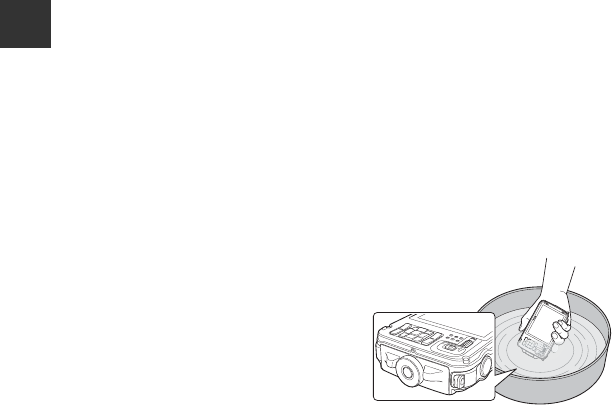
xiv
<Important> Shockproof, Waterproof, Dustproof, Condensation, GPS
Introduction
Cleaning after Using the Camera Underwater
• After using the camera underwater, clean the camera within 60 minutes. If you
leave the camera in wet conditions where salt particles or other foreign
substances are adhered to it, this could cause damage, discoloration, corrosion,
a bad smell or deterioration of waterproof performance.
• Before cleaning the camera, thoroughly remove water droplets, sand, salt
particles, or other foreign substances from your hands, body, and hair.
• It is recommended to clean the camera indoors to avoid a place where it could
be exposed to water spray or sand.
• Do not open the battery-chamber/memory card slot cover until all foreign
substances are washed off with water and all moisture is wiped off.
1. Keep the battery-chamber/memory card slot cover closed and wash off
the camera with fresh water.
Immerse the camera in a shallow basin
filled with fresh water (such as tap water
and well-water that do not contain salt)
for 10 minutes.
• If the buttons or switches do not
operate properly, foreign substances
may have adhered. Since this could
cause a malfunction, immerse the
camera in fresh water and shake it
sufficiently in the water to remove the any foreign substances from the camera.
• When the camera is immersed in the water, a few air bubbles may come out
from the water drain holes of the camera such as openings in the microphone
or speakers. This is not a malfunction.
2. Wipe off water droplets with a soft cloth and dry the camera in the well-
ventilated and shady place.
• Place the camera on a dry cloth to dry it.
Water will flow out from openings in the microphone or speakers.
• Do not dry the camera with hot air from a hair dryer or clothes dryer.
• Do not use chemicals (such as benzine, thinner, alcohol, or cleanser), soap, or
neutral detergents.
If the waterproof packing or body of the camera becomes deformed, the
waterproof performance will deteriorate.


















